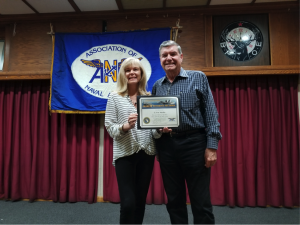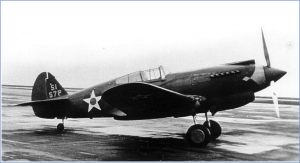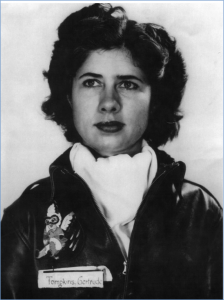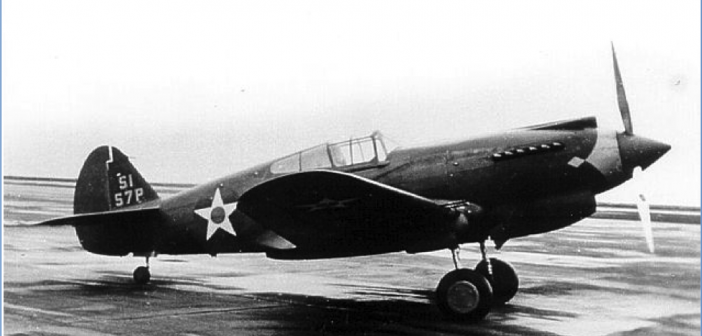 The Grampaw Pettibone Squadron was once again honored to have G. Pat Macha share his knowledge and research of local historic aircraft wrecks and the causes leading up to the crashes. His sister Cindy Macha, GPS Ops Officer introduced our speaker.
The Grampaw Pettibone Squadron was once again honored to have G. Pat Macha share his knowledge and research of local historic aircraft wrecks and the causes leading up to the crashes. His sister Cindy Macha, GPS Ops Officer introduced our speaker.
For those unfamiliar with Pat, he became involved with aircraft crash site investigation beginning in 1963 as a teenager, while working as a hike master in a youth camp in the San Bernardino Mountains. While leading an overnight hike, his group came upon an accident crash site containing what Pat recognized as a C47 (DC3). Pat’s love of everything airplane comes from his father and interest in the question ‘what happened?’
Pat’s presentation described circumstances and subsequent findings surrounding more than a dozen different aircraft accidents involving military aircraft.
 In October 1941, just before WWII started, the US Army Air Corps was conducting war games. A total of 25 P-40 aircraft from the 57th Pursuit Group departed from the east coast and flew cross-country to March Field in Southern California. Due to mechanical issues and sick pilots, only 19 aircraft departed on 24 October from March to fly to McClellan Field near Sacramento. The weather was bad but the order was given to depart. Only five P-40s safely made it to McClellan. Nine aircraft made forced landings across central California and western Nevada. The remaining five aircraft crashed and two pilots were killed. Four were located including the latest in June 2016 which was piloted by then 2Lt. John Pease.
In October 1941, just before WWII started, the US Army Air Corps was conducting war games. A total of 25 P-40 aircraft from the 57th Pursuit Group departed from the east coast and flew cross-country to March Field in Southern California. Due to mechanical issues and sick pilots, only 19 aircraft departed on 24 October from March to fly to McClellan Field near Sacramento. The weather was bad but the order was given to depart. Only five P-40s safely made it to McClellan. Nine aircraft made forced landings across central California and western Nevada. The remaining five aircraft crashed and two pilots were killed. Four were located including the latest in June 2016 which was piloted by then 2Lt. John Pease.
Lt. Pease though injured, successfully hiked out from the crash site and located a house with occupants who drove him to the nearest town and notified authorities. Colonel John H. Pease when he retired in 1970 after a thirty year military career was Deputy Inspector General of the Aerospace Defense Command.
In June 2016, the Colonel’s plane was found by a hiker who contacted Pat. Pat contacted a member of his Project Remembrance Team to try and locate Colonel Pease. The Colonel who is in his late 90s was contacted by Pat. He was very alert when reached and requested that Pat recover some of his personal belongings that were in the aircraft. The aircraft site was searched, however, the items were not found.
Two other pilots from the same flight, Leonard Lydon and Jack West were interviewed by Pat. After surviving nine days in a remote cabin they began to hike out and were located by an Air Corps B-18 Bolo Bomber on the search. After dropping survival equipment, the two waited to be brought out.
The return flight lost three more aircraft, two of which were fatal. A monument was added to the crash site.
The next event was a request from the crew chief and relative of a crew member of a B-47 which crashed near March field. This was submitted to Pat through Project Remembrance. Project Remembrance is a volunteer organization dedicated to facilitate requests of next of kin who wish to learn more about the loss of loved ones in aircraft accidents. With permission from the Base CO, Pat took these individuals to the site to provide closure and place a monument on the site.
Pat received a request from a surviving family member to visit a site of a B-24 that crashed in N. California in 1942. The site while on private property was visited after the owner granted permission. With permission a plaque was erected to recognize the sacrifice made by the crew while on a mission.
One of the most fascinating stories was about the crash of a C-53 in 1943 that left Van Nuys on a severe windy day for the purpose of towing a Waco CG-4 glider to Victorville over the mountains. The glider pulled the tail off the C-53 over the community of Castaic. The glider crew bailed out and the C-53 crew made a hard landing. The wreck was found by a nine year old girl, Mary Lyn Winkler, who lived in the area. She was much appreciated and received personal thanks from General Hap Arnold
A P-61 flying as a chase plane for a YB-49 flight on 21 October 1947, with a pilot and two photographers on-board, experienced an engine fire. Chuck Yeager flying a P-80 on the same mission noticed the engine fire and notified the pilot. All were able to bail out successfull y. Pat was able to visit the site and recover parts.
An instrument training flight in cloudy weather conditions on 18 November 1950, with four on-board in a USMC SNB-5 (Beech 18) aircraft was flying from Yuma to El Toro. The pilot was given a heading by the controller in the El Toro area who then became distracted. The pilot based on the navigation instructions, flew into a canyon and was unable to reverse course. All onboard were killed. As a result of a local brush fire in 2007, the crash site wreckage was revealed and reported in the press. Family members contacted Pat requesting information. in 2008 a memorial marker was placed at the site.
Within a short distance from the SNB-5 site, the wreckage of a Navy SP2-E that crashed 11 February 1969 with seven on-board was also revealed. A request from family members to erect a memorial was denied. However, permission was granted to attach containers to the wreckage and leave memorialized objects.
Pat continued to review a list of military accidents and shared information surrounding the crash of a U.S. Navy Douglas A4D-2 on a low level training mission on 8 July 1959. During the flight the aircraft engine exploded and the pilot, Commander “Deke” Joralmon upon ejecting from the aircraft was unable to obtain a full chute deployment and was subsequently killed. His son contacted Pat in 2007, and with BLM approval was able to visit the site in 2008 with Pat, and erect a memorial stone marker.
 One event during WWII that continues to elicit interest is the disappearance of Gertrude “Tommy” Tompkins, a WASP. During WWII, significant contributions were made by the many women who served with distinction, as Women Airforce Service Pilots(W ASP). Tommy Tompkins was scheduled to depart 26 October 1944 in a P-51D from Mines Field (LAX) to Newark, New Jersey but was delayed due to mechanical issues with the canopy of the aircraft. At 4pm the flight of three departed into a cloud covered sky. Two of the aircraft arrived as expected, however, no trace was found of the third plane. Searching the waters off the Santa Monica coast continue to this day and while other aircraft have been found, no evidence of the missing P-51D has been located to date.
One event during WWII that continues to elicit interest is the disappearance of Gertrude “Tommy” Tompkins, a WASP. During WWII, significant contributions were made by the many women who served with distinction, as Women Airforce Service Pilots(W ASP). Tommy Tompkins was scheduled to depart 26 October 1944 in a P-51D from Mines Field (LAX) to Newark, New Jersey but was delayed due to mechanical issues with the canopy of the aircraft. At 4pm the flight of three departed into a cloud covered sky. Two of the aircraft arrived as expected, however, no trace was found of the third plane. Searching the waters off the Santa Monica coast continue to this day and while other aircraft have been found, no evidence of the missing P-51D has been located to date.
Pat noted that assisting in the search for the missing P-51D is Gary Fabian, founder of UB88.org. He is a maritime historian and shipwreck researcher. He identified 90 hotspots in Santa Monica Bay in which two were aircraft, one a general aviation and the second thought to be the missing P-51. As it turned out, the wreck was a T-33 jet trainer. The plane disappeared on 15 October 1955 with a crew of 2 on a training flight.
When the news of the discovery was announced, a request to hold a memorial was received by Pat from the family. The memorial was held at Dockweiler Beach on 5 March 2010. A significant turnout by family and friends for the event occurred and recognition of the sacrifice by 1Lt.Richard Theiler and 1Lt.Paul Smith.
Pat discussed the event of USAF Lt. David Steeves, pilot of a T-33 on 9 May 1957. The flight to go from a base near Oakland to Luke AFB. The plane did not arrive and after two weeks the pilot declared legally dead.
Fifty-four days after the flight the pilot was found. He claimed to have survived the bail-out but injured both his ankles and used his survival skills as he looked for shelter and food. Finding a ranger’s cabin that had some supplies, he regained his strength. Leaving the cabin he continued to search for a way out of the wilderness and was found by two guides with a pack mule train. Returning to civilization he was initially hailed as a hero. After the snows melted, a search for the plane failed to find any wreckage. Lt. Steeves was under suspicion that he stole the plane. The inquiry found no evidence to support the charge, however, because of the suspicion he resigned the Air Force and his wife left him. He continued to search for the wreckage without success. In 1966, he died in a light plane crash. In 1977, Boy Scouts hiking through Kings Canyon National Park came across a portion of a cockpit canopy frame. The serial number on the piece matched the missing T-33. The rest of the aircraft has never been found
Two years ago Pat received a call from hikers who claim to have located an aircraft in a lake in a remote area of the Sierras. Divers sent to the area located the lake and the aircraft which turned out to be a helicopter. The helicopter a Bell 204, military designation HU-1A was in an accident on 2 August 1962. Some years before the helicopter was located, Chuck Yeager wrote a book about his career and described a helicopter accident in which he was a passenger. Research on the discovery revealed this was the helicopter.




